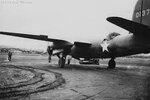swampyankee
Chief Master Sergeant
- 4,158
- Jun 25, 2013
...yet the last generation of piston-engined attack aircraft and all the jet-propelled ones eschewed the back-seat gunner as superfluous.
When you have enough fighters, which the USN didn't early in WW2, it's better to defend attack aircraft by putting the guns into the fighters. Of course, that back-seat gunner has one or two rifle-caliber machine guns, while the fighters tended to have HMG or cannon
When you have enough fighters, which the USN didn't early in WW2, it's better to defend attack aircraft by putting the guns into the fighters. Of course, that back-seat gunner has one or two rifle-caliber machine guns, while the fighters tended to have HMG or cannon

